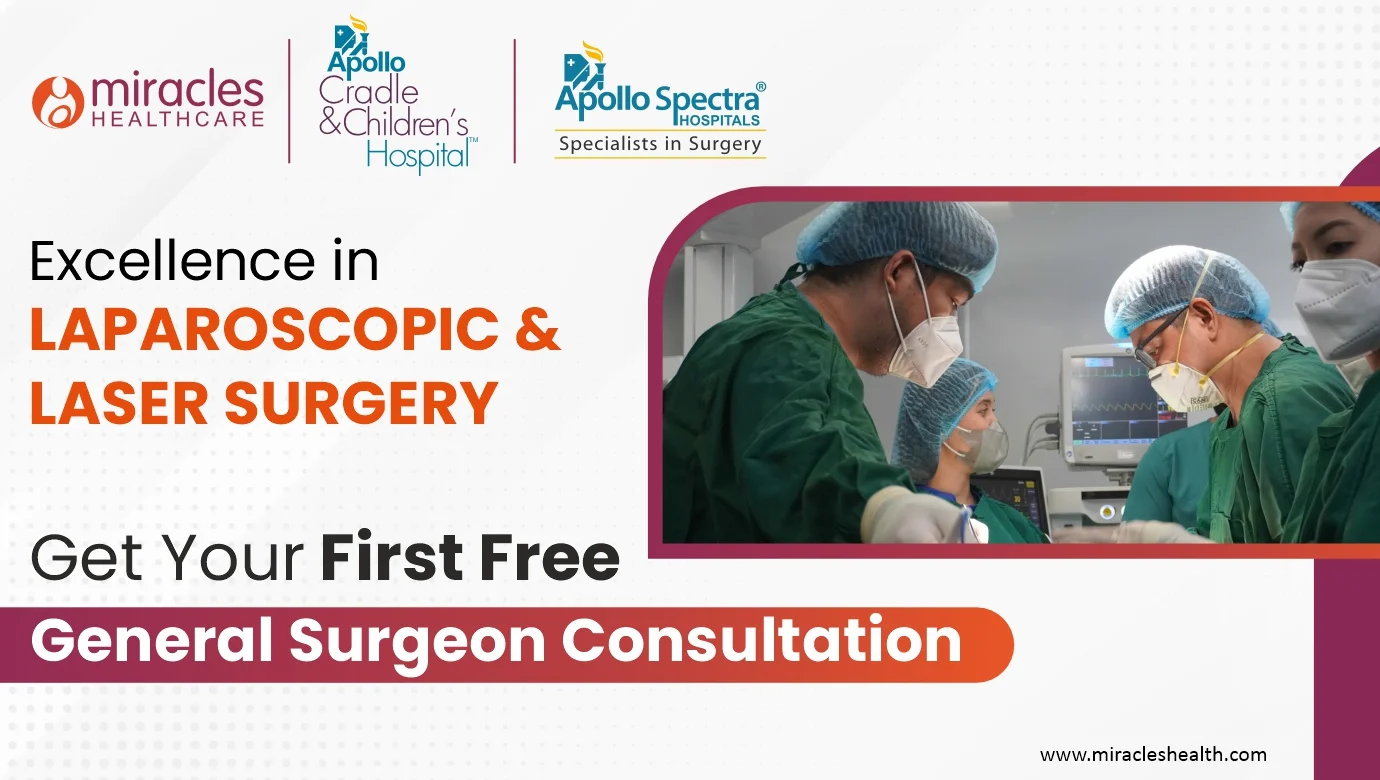General Surgery Conditions We Treat
Comprehensive Care for Your Health

Laparoscopic appendectomy is a minimally invasive surgical procedure used to remove an inflamed appendix. It involves making small incisions in the abdomen through which a camera and surgical instruments are inserted. This technique offers quicker recovery, less postoperative pain, and shorter hospital stays than traditional open surgery.
Laparoscopic appendectomy is a surgical procedure performed to remove an inflamed or infected appendix. It's typically done under general anesthesia. The surgeon makes small incisions in the abdomen and inserts a laparoscope, a thin tube with a camera and light, to visualize the appendix and surrounding tissue. The appendix laparoscopic surgery is a minimally invasive approach that offers several advantages over traditional open surgery, including smaller incisions, reduced postoperative pain, faster recovery, shorter hospital stays, and decreased risk of surgical site infections. It's particularly beneficial for patients who are obese or have underlying health conditions.
Appendicitis: The primary indication for appendectomy is appendicitis, an inflammation of the appendix. This condition can lead to serious complications such as rupture, which can be life-threatening if not immediately treated.
Abdominal Pain: Persistent or severe abdominal pain, particularly in the lower right quadrant, may indicate appendicitis and necessitate removal of the appendix.
Diagnostic Confirmation: Laparoscopic appendectomy not only treats appendicitis but also serves as a diagnostic tool. The laparoscope allows the surgeon to visually inspect the appendix and surrounding structures for signs of inflammation or infection.
Prevention of Complications: Removing the inflamed appendix helps prevent complications such as appendiceal rupture, abscess formation, and peritonitis, which can lead to systemic infection and sepsis.
Resolution of Symptoms: Patients with appendicitis typically experience symptoms such as abdominal pain, nausea, vomiting, and fever. Appendectomy alleviates these symptoms by removing the source of inflammation.
Minimally Invasive Approach: Laparoscopic appendectomy offers the benefits of smaller incisions, reduced postoperative pain, faster recovery, and shorter hospital stays compared to traditional open surgery, making it a preferred choice for many patients.
Obesity or Coexisting Conditions: Patients who are obese or have underlying health conditions may benefit from the minimally invasive nature of laparoscopic surgery, which reduces the risk of complications associated with larger incisions.
Quicker Return to Normal Activities: Laparoscopic appendectomy allows patients to resume their normal activities sooner than open surgery, enhancing overall quality of life and productivity.
The ideal candidate for laparoscopic appendectomy typically meets the following criteria:
Diagnosed with Appendicitis:The patient should have a confirmed diagnosis of appendicitis through clinical evaluation, imaging studies (such as ultrasound or CT Scan), and laboratory tests (such as white blood cell count).
Absence of Severe Complications: Laparoscopic appendectomy is suitable for patients with uncomplicated appendicitis or minimal complications. Severe complications such as abscess formation or generalized peritonitis may require open surgery.
Stable Vital Signs: The patient should have stable vital signs, including normal blood pressure, heart rate, and oxygen saturation, indicating that they can tolerate general anesthesia and surgical intervention.
Reasonable Surgical Risk: The patient should be deemed fit for surgery based on their overall health status, absence of significant comorbidities, and ability to undergo general anesthesia without undue risk.
Suitable Anatomy: Laparoscopic appendectomy requires adequate visualization and access to the appendix and surrounding structures. Patients with complex abdominal anatomy or extensive adhesions may not be suitable candidates.
The individual patient characteristics and clinical circumstances may influence the decision- making process regarding the choice of surgical approach. A thorough evaluation by a surgeon, including a discussion of the risks and benefits, is essential in determining whether appendicitis laparoscopic surgery is the right option for a particular patient.
Preparing for appendix removal laparoscopic surgery involves several steps to ensure a successful surgery and smooth recovery. Here's a guide:
Medical Evaluation: Your surgeon will conduct a thorough medical evaluation to assess your overall health status and any pre-existing medical conditions that may affect the surgery or anesthesia.
Imaging Studies: Depending on your symptoms and clinical presentation, your doctor may order imaging studies such as ultrasound or CT scan to confirm the diagnosis of appendicitis and evaluate the extent of inflammation.
Preoperative Instructions: Follow any preoperative instructions provided by your surgeon or healthcare team, which may include fasting for a certain period before the surgery to ensure your stomach is empty.
Medication Review: Inform your surgeons about all medications you are currently taking, including prescription medications, over-the-counter drugs, and supplements. Your doctor may advise you to stop taking certain medications before the surgery, especially blood thinners or anti-inflammatory drugs that can increase the risk of bleeding.
Smoking Cessation: If you smoke, consider quitting or reducing smoking before the surgery, as smoking can impair healing and increase the risk of complications.
Follow Dietary Guidelines: Follow any specific dietary guidelines provided by your surgeons, such as avoiding certain foods or drinks before the surgery.
By following these steps and collaborating closely with your surgeon, you can effectively prepare for a laparoscopic appendectomy and optimize your chances of a successful outcome.
The appendectomy laparoscopic procedure is typically performed under general anesthesia and involves the following steps:
Preparation: You will be positioned on the operating table, and monitors will be attached to monitor your vital signs. The surgical team will cleanse and sterilize the abdominal area.
Incision: The surgeon makes small incisions (usually 3-4) in the abdomen, each about half an inch to an inch in length. These incisions serve as ports for the laparoscope and surgical instruments.
Insufflation: Carbon dioxide gas is introduced into the abdomen through one of the incisions. This gas helps to create a space inside the abdomen, allowing the surgeon to see and access the organs more easily.
Insertion of Laparoscope: A laparoscope is inserted through one of the incisions. The camera provides a magnified view of the abdominal cavity on a monitor, allowing the surgeon to visualize the appendix and surrounding structures.
Instrument Placement: Specialized laparoscopic instruments, such as graspers, scissors, and dissectors, are inserted through the remaining incisions. These instruments are used to manipulate and dissect the tissues, allowing access to the appendix.
Identification of the Appendix: The surgeon carefully identifies the appendix, which is typically located in the lower right quadrant of the abdomen. In cases of complicated or hidden appendices, additional maneuvers may be necessary to locate and expose the appendix.
Surgical procedure: Using the laparoscopic instruments, the surgeon carefully dissects the tissue surrounding the appendix to free it from its attachments. Blood vessels supplying the appendix are sealed off using electrocautery or clips to minimize bleeding. The appendix is then tied off and removed from the abdomen.
Closure: Once the appendix is removed, the surgical incisions are closed with sutures, staples, or adhesive strips. In some cases, absorbable sutures may be used, eliminating the need for removal.
Recovery: After the procedure, you will be taken to a recovery area where your vital signs will be monitored as you wake up from anesthesia. Most patients can go home the same day or after a short hospital stay, depending on their recovery and the surgeon's discretion.
Laparoscopic appendectomy offers several advantages over traditional open surgery, including smaller incisions, reduced postoperative pain, faster recovery, and shorter hospital stays. However, it may not be suitable for all patients, especially those with severe complications or extensive abdominal adhesions. Your surgeon will determine the most appropriate surgical approach based on your case.
Laparoscopic appendectomy offers various advantages over open surgery:
Smaller Incisions: Laparoscopic appendectomy requires only small incisions (typically 3- 4), which are usually less than an inch in length. This results in less tissue trauma, reduced scarring, and improved cosmetic outcomes.
Minimally Invasive: The laparoscopic approach involves inserting a thin tube with a camera and surgical instruments through small incisions, rather than making a large open incision. This minimizes damage to surrounding tissues and organs, leading to less pain and faster recovery.
Faster Recovery: Patients undergoing laparoscopic appendectomy often experience a quicker recovery compared to open surgery. They may have shorter hospital stays and can typically resume normal activities, including work and exercise, sooner.
Reduced Postoperative Pain: Because laparoscopic appendectomy involves smaller incisions and less tissue trauma, patients generally experience less postoperative pain compared to open surgery. This can lead to decreased reliance on pain medications and a more comfortable recovery period.
Lower Risk of Surgical Site Infections: With smaller incisions and reduced tissue exposure, laparoscopic appendectomy carries a lower risk of surgical site infections compared to open surgery. This can contribute to faster wound healing and decreased risk of complications.
Improved Cosmetic Outcome: The small incisions used in laparoscopic appendectomy result in minimal scarring, which may be more aesthetically pleasing compared to the larger scar associated with open surgery. This can be particularly important for patients concerned about the cosmetic appearance of their abdomen.
Decreased Risk of Hernia Formation: The risk of developing an incisional hernia, where tissue protrudes through the surgical incision, is lower with laparoscopic appendectomy due to the smaller incisions and decreased disruption of the abdominal wall.
Better Visualization: The laparoscope provides magnified, high-definition images of the abdominal cavity, allowing for better visualization of the appendix and surrounding structures. This facilitates precise surgical techniques and reduces the risk of complications.
Overall, laparoscopic appendectomy offers numerous advantages in terms of reduced pain, faster recovery, improved cosmesis, and decreased risk of complications compared to traditional open surgery. However, not all cases are suitable for the laparoscopic approach, and the decision to perform laparoscopic versus open appendectomy depends on factors such as the patient's condition, surgeon's expertise, and intraoperative findings.
While laparoscopic appendectomy is generally considered safe, like any surgical procedure, it carries certain risks and potential complications. These may include:
Bleeding: There is a risk of bleeding during the procedure, particularly when dissecting and removing the appendix. In most cases, bleeding can be controlled using specialized instruments and techniques. However, excessive bleeding may require additional intervention or conversion to open surgery.
Infection: Although laparoscopic appendectomy reduces the risk of surgical site infections compared to open surgery, there is still a possibility of infection. This can include infections at the incision sites or within the abdominal cavity. Antibiotics may be prescribed before or after surgery to reduce this risk.
Organ Damage: During the procedure, there is a small risk of unintentional injury to nearby organs such as the intestines, bladder, or blood vessels. Careful surgical technique and visualization with the laparoscope help minimize this risk, but it cannot be eliminated.
Anesthesia Risks: General anesthesia carries its own set of risks, including allergic reactions, respiratory problems, and adverse reactions to anesthesia medications. Your anesthesiologist will carefully monitor you throughout the procedure to minimize these risks.
Pneumoperitoneum-related Complications: The insufflation of carbon dioxide gas into the abdomen to create space for the surgery can lead to complications such as subcutaneous emphysema (air under the skin), respiratory compromise, or cardiovascular effects. These are rare but can occur, especially in patients with pre- existing lung or heart conditions.
Postoperative Pain: While laparoscopic appendectomy typically results in less postoperative pain compared to open surgery, some degree of discomfort or pain is normal after any surgical procedure. Pain management strategies such as medications, ice packs, and rest can help alleviate discomfort during the recovery period.
Conversion to Open Surgery: In some cases, the surgeon may encounter difficulties during the laparoscopic procedure, such as extensive adhesions, complex anatomy, or unexpected complications. In such situations, the surgeon may need to convert to open surgery to safely complete the procedure.
Rare Complications: Rare complications of laparoscopic appendectomy may include blood clots, bowel obstruction, hernia formation, or damage to nerves or blood vessels. While these complications are uncommon, they can potentially occur and may require further treatment.
Discuss the potential risks and benefits of laparoscopic appendectomy with your surgeon before undergoing the procedure. They can provide personalized information based on your medical history, individual risk factors, and the specific details of your case.
After a laparoscopic appendectomy, here's what you can generally expect during the recovery period:
Hospital Stay: Most patients can go home the same day of the surgery or after a short hospital stay, depending on their overall condition and the surgeon's recommendation.
Pain Management: You may experience some discomfort or pain at the incision sites and in the abdomen. Your surgeon will prescribe pain medications to help manage any discomfort. Over-the-counter pain relievers may also be recommended.
Activity Level: Initially, you may need to limit physical activity and avoid heavy lifting for a few days to allow your body to heal. Your surgeon will provide specific guidelines regarding when you can gradually resume normal activities and return to work or school.
Diet: You may start with clear liquids and gradually advance to a normal diet as tolerated. It's essential to stay hydrated and eat nutritious foods to support the healing process. Your surgeon may recommend avoiding certain foods or beverages that can irritate the digestive system.
Incision Care: You will need to keep the incision sites clean and dry to prevent infection. Your surgeon may provide instructions on how to care for the incisions, including when to remove any dressings and how to shower safely.
Follow-up Appointments: You will need to schedule follow-up appointments with your surgeon to monitor your recovery progress. During these appointments, your surgeon will evaluate your incisions, assess your overall health, and address any concerns or questions you may have.
Return of Bowel Function: It's common to experience temporary changes in bowel habits, such as constipation or diarrhea, after surgery. Eating a balanced diet with plenty of fiber, staying hydrated, and gradually increasing physical activity can help promote regular bowel function.
Resuming Normal Activities: As you recover, you can gradually increase your activity level and resume normal daily activities. However, it's essential to listen to your body and avoid overexertion or activities that cause discomfort.
Potential Complications: While complications after laparoscopic appendectomy are rare, it's important to be aware of warning signs such as fever, severe abdominal pain, persistent nausea or vomiting, redness or drainage at the incision sites, or difficulty urinating. If you experience any of these symptoms, contact your surgeon immediately for diagnosis and treatment.
Overall, most patients recover well after laparoscopic appendectomy and can return to their usual activities within a few days to weeks, depending on individual factors and the extent of the surgery. Following your surgeon's instructions, staying vigilant for signs of complications, and allowing yourself time to rest and heal are essential for a successful recovery.
After laparoscopic appendectomy, it's important to follow these care instructions to promote healing and minimize complications:
Monitor Incisions: Keep the incision sites clean and dry. Check them daily for signs of infection such as redness, swelling, warmth, or drainage. Report any concerns to your surgeon.
Follow Activity Restrictions: Initially, avoid strenuous activities, heavy lifting, and intense exercise. Gradually increase your activity level as tolerated, following your surgeon's recommendations.
Take Pain Medications: Take pain medications as prescribed by your surgeon to manage discomfort. Over-the-counter pain relievers may also be used as prescribed.
Stay Hydrated: Drink plenty of fluids to stay hydrated, which can help with healing and prevent constipation. Aim for at least 8 glasses of water per day unless otherwise directed by your surgeon.
Eat a Healthy Diet: Follow a balanced diet rich in fruits, vegetables, lean proteins, and whole grains. Avoid foods that may irritate your digestive system, such as spicy or greasy foods, until you are fully recovered.
Practice Proper Wound Care: If your surgeon provides specific wound care instructions, follow them carefully. This may include changing dressings, keeping the incision sites clean, and avoiding activities that could disrupt the healing process.
Attend Follow-up Appointments: Schedule and attend all follow-up appointments with your surgeon as directed. These appointments allow your surgeon to monitor your recovery progress, assess incisions, and address any concerns or complications.
Avoid Smoking and Alcohol: If you smoke, try to quit or minimize smoking as it can impair healing and increase the risk of complications. Avoid alcohol consumption during the initial recovery period, as it can interfere with medication and slow healing.
Rest: Give yourself time to rest and recuperate after surgery. Listen to your body and avoid overexertion. Adequate rest is necessary for proper healing.
Watch for Warning Signs: Be aware of potential signs of complications, such as fever, severe abdominal pain, persistent nausea or vomiting, difficulty urinating, or signs of infection at the incision sites. If you experience any of these symptoms, contact your surgeon immediately.
Following these care instructions can help ensure a smooth recovery and reduce the risk of complications after laparoscopic appendectomy. Always consult your surgeon if you have any questions or concerns about your recovery or if you experience any unusual symptoms.
Several factors can influence the laparoscopic appendectomy surgery cost:
Hospital or Surgical Facility Fees: The fees charged by the hospital or surgical facility where the procedure is performed can vary widely based on factors such as location, facilities available, and the hospital's reputation.
Surgeon's Fees: The surgeon's fees for performing the laparoscopic appendectomy will depend on their level of expertise, experience, and geographical location. Surgeons with specialized training or those practicing in urban areas may charge higher fees.
Anesthesia Fees: Anesthesia services, including the administration of general anesthesia during the procedure, are typically billed separately from the surgical fees. The cost can vary based on the type of anesthesia used and the duration of the procedure.
Preoperative Evaluation and Testing: The cost of preoperative evaluations, such as laboratory tests, imaging studies (such as ultrasound or CT scan), and consultations with a surgeon, can contribute to the overall cost of the procedure.
Postoperative Care and Follow-up: The cost of postoperative care, including medications, follow-up appointments, and any necessary tests or imaging studies, should also be considered.
Health Insurance Coverage: The extent of health insurance coverage can significantly affect the out-of-pocket costs for the patient. Insurance plans may cover all or a portion of the expenses related to laparoscopic appendectomy, depending on the type of plan and specific policy details.
Complications or Additional Procedures: If complications arise during the procedure or if additional procedures are required, such as drainage of abscesses or conversion to open surgery, these can increase the overall cost of treatment.
Patient Factors: Individual patient factors, such as age, overall health, presence of pre- existing medical conditions, and complexity of the case, can influence the cost of laparoscopic appendectomy. Patients with more complex medical needs or those requiring specialized care may incur higher costs.
Geographical Location: The cost of healthcare services can vary significantly depending on the geographical location, with procedures generally being more expensive in urban areas and regions with higher costs of living.
Negotiation and Discounts: Some surgeons may offer discounts or negotiate payment arrangements for patients without insurance coverage or those facing financial hardship. Patients should inquire about available options for reducing costs and explore payment plans or financial assistance programs if needed.
Patients need to discuss the potential costs of laparoscopic appendectomy with their surgeons and insurance companies before undergoing the procedure to understand their financial obligations and explore available options for payment and coverage.
Miracles Apollo Cradle/Spectra stands out as the best hospital for laparoscopic appendectomy in Gurgaon. Our specialized team of highly experienced general surgery doctors in Gurgaon ensures that patients receive top-notch care and expertise throughout their treatment journey.
Our state-of-the-art facilities and advanced technology enable us to perform laparoscopic appendectomies with precision and minimal invasiveness, leading to quicker recovery times and reduced post-operative discomfort. We provide comprehensive pre-operative evaluations, personalized treatment plans, and compassionate post-operative care to ensure the best possible results for our patients.
Whether you're seeking treatment for appendicitis or any other general surgery needs, you can trust us for exceptional care and positive outcomes.


Comprehensive Care for Your Health
Meet our expert team of General Surgeon where compassionate care meets expertise.
Inspiring Journeys: True Patient Stories
Miracles Apollo Cradle is a leading Maternity Hospital Gurgaon. We strive to give the best care to our patients.






Your Health, Our Network: Comprehensive Care Across Every Facility.
Learn about the world class health care we provide
Expert Advice and Health Tips
Learn about the world class health care we provide
Laparoscopy appendix recovery time is typically 1-3 weeks for full recovery.
Yes, laparoscopic appendectomy is considered a minor surgery.
The appendix is removed during an appendectomy.
The cost of laparoscopic appendix surgery can vary, ranging from a few thousand to several thousand dollars, depending on various factors.